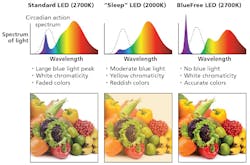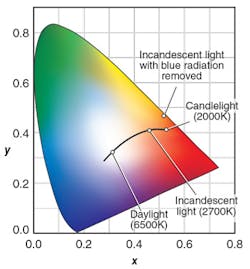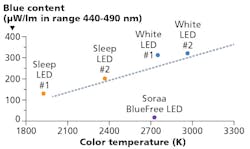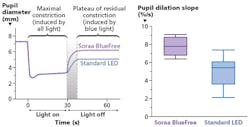Blue-free white light breaks the paradigm of circadian lighting (MAGAZINE)
Non-visual receptors in humans are especially sensitive to blue spectral energy, explains AURELIEN DAVID, and the latest LED technology enables high-quality white light with reduced blue content that can enhance circadian health.
The impact of light on our sleep cycle and health is a major medical discovery of the last two decades. Artificial light, which is ubiquitous in modern societies, can influence the circadian cycle just like daylight does. This is both an exciting opportunity for the solid-state lighting (SSL) sector, and a cause for potential concern. Let's discuss what is known about the non-visual aspects of light and consider how LED-based sources can evolve to enhance human health and wellbeing.
Interested in articles & announcements on LED technology & design for circadian lighting?
In the early 2000s, based on seminal research on light and sleep, researchers identified yet-unknown receptors in our retinas: the so-called intrinsically-photosensitive retinal ganglion cells (ipRGCs). These receptors are sensitive to light, but rather than causing a visual stimulus (like the well-known rods and cones), they connect directly to the part of our brain that regulates our sleep patterns - the circadian cycle. For more background, see an LEDs Magazine interview that discusses an article from academics on the topic.
What is most important about these receptors is their sensitivity to blue light - their peak sensitivity is at a wavelength of about 450-480 nm. When excited with light, they send a wakeup signal. This signal is observed in various physiological responses; for instance, it prevents our bodies from releasing the hormone melatonin, which strongly correlates to our circadian cycle. This maximal sensitivity to blue light makes sense as it relates to natural sunlight: Blue radiation is more prevalent in the morning, diminishes throughout the day, and is absent at night; therefore, our bodies use it as a cue to synchronize the internal clock.
Opportunities and challenges
On the one hand, it is possible to provide additional light to help those who wouldn't get enough from natural conditions. For instance, a jolt of blue light in the morning may help those living in sun-deprived locations, or populations whose circadian cycles are naturally less well-regulated such as teenagers and the elderly. We are especially sensitive to early-morning blue light, in the first one to two hours of our day.
On the other hand, exposure to light in the evening can have unwanted effects. Research has shown that common indoor lighting conditions (100 lx and above) are enough to significantly impact the circadian cycle. Such effects persist for several hours after light is turned off, and can thus delay the onset of sleep. Display light from phones and tablets is an additional cause for concern. This worry has become even more acute with the spread of LED lighting, which uses blue-pump LEDs whose intense blue radiation can be especially impactful.
The topic has become prominent enough to trigger statements from a variety of authorities, such as the American Medical Association (AMA) and the US Department of Energy (DOE). LEDs Magazine, for instance, has published a number of articles focused on recent AMA recommendations for warm-CCT outdoor lighting. Influential tech companies, as well as big players in the lighting industry, are attempting to address blue-light concerns in their most recent circadian-friendly products, including displays and light sources. But what is the underlying technology, and what are its limitations?
Tuning spectra for the circadian cycle
Circadian entrainment is proportional to the total dose of blue light, which is the product of two factors: the total light amount where more light causes higher stimulation, and the relative amount of blue radiation in the spectrum of the light where more blue radiation causes higher stimulation. To influence the circadian cycle, one may therefore alter the light level and the spectrum.
Learn more about human-centric lighting and how light promotes health and productivity at the 2017 Lighting for Health and Wellbeing conference July 27 in Newport Beach, CA:lightingforhealthandwellbeing.com
Various metrics have been proposed to quantify the total dose of blue light, such as the melanopic lux defined by Lucas. Their accuracy is still being assessed - a task that is complicated by our imperfect knowledge of the circadian action spectrum. However, it is well-accepted that this action spectrum has a peak sensitivity at about 450-480 nm. Therefore, modifying the spectrum of light in this range provides the most opportunity to affect circadian entrainment.
LED technology makes it possible to shape a spectrum as desired, and in particular to reorganize the spectrum to add or remove blue radiation, but this must be done while maintaining other important properties of the light. A crucial aspect is the chromaticity of the light itself, which should remain white. This constraint is not trivial: If one simply starts from a white light source and removes all blue radiation (for instance, with a blue-suppressing filter), the resulting light suffers from a very yellow-greenish tint that is too unpleasant for practical use. Therefore, decreasing the circadian stimulation of a light source can't be reduced to simply removing blue radiation.
Morning and evening needs
White light is characterized by its correlated color temperature (CCT). High-temperature light - for instance, daylight - contains more short-wavelength radiation, whereas low-temperature light is richer in red radiation (Fig. 1). This leads to a simple strategy to tune the circadian stimulation of a light source by tuning its CCT and intensity - higher in the morning and lower at night. The human vision system naturally adapts to light of different CCTs through the process of chromatic adaptation, so a wide range of CCTs is acceptable for general lighting.
This approach works well to increase circadian entrainment in the morning, by raising the CCT to 4000-5000K and increasing light intensity to 1000 lx and beyond. Various medical studies have confirmed that blue-rich, high-CCT light could help synchronize the sleep schedule, in particular for populations whose circadian cycle is otherwise altered by a medical condition. Accordingly, the lighting industry has embraced this concept and introduced a number of products with enriched blue radiation in the morning.
On the other hand, it is much more challenging to create a source with low circadian stimulation in the evening. To reduce the total blue dose, both the amount of light and the spectrum must be adapted. Light intensity can be reduced somewhat, say from a typical 100-300 lx down to 30-50 lx, but lower values become too dim for domestic use. An even more serious challenge arises when trying to obtain a spectrum with very little blue radiation, as lowering the color temperature reaches a limit. If the CCT goes far below 2700K - the temperature of an incandescent bulb - chromatic adaptation becomes imperfect. The light appears yellowish despite being technically characterized as white light since it lies on the black-body locus. An example is the light produced by a candle; with a CCT of 2000K, it may be pleasant in specific contexts but looks far too yellow for most domestic activities.
Today, all commercial sleep-friendly bulbs use this low-temperature approach (with temperatures in the range from 2000-2300K) and thus suffer from an unnatural light color. Because of this problematic color quality, manufacturers suggest that such bulbs only be used in a few lighting fixtures, for instance, bedside lamps. It is worth noting that the effectiveness of these products so far hasn't been confirmed by clinical studies.
This same approach is also used for displays: From computer utilities like f.lux to smartphone features such as Apple's Nightshift, the amount of blue radiation is reduced by lowering the color temperature of the screen at night. Here again, the temperature can only be lowered to a certain point (about 3500K) before the screen looks unacceptably yellowish.
Fig. 2 indicates the blue radiation content for various commercial light sources, and shows that it is essentially dictated by the color temperature. This reveals a seemingly unescapable tradeoff, where low-blue can only be obtained at the cost of a very yellow light tint. In fact, this tradeoff stems from a basic property of conventional LED technology: the reliance on blue-pump LEDs to generate a white spectrum, which causes the amount of blue radiation and the light chromaticity to be fundamentally correlated.
A blue-free solution
Having identified and understood the root cause of this tradeoff, it is actually possible to circumvent it and offer true white light with minimal blue content. One example is the BlueFree SSL technology developed by Soraa. It hinges on replacing standard blue-pump LEDs with violet-pump LEDs, and carefully shaping the spectrum of the light source to create a blue gap. By removing energy in a relatively narrow spectral range, it is possible to retain the color temperature of an incandescent light while virtually removing any blue radiation from the spectrum.
Although the use of blue-pump LEDs has been unquestioned for two decades, the last five years have seen the rise of full-spectrum white LEDs based on violet-pump LEDs. This may be counterintuitive at first, since conventional wisdom asserts that the lower Stokes-loss of blue-pump LEDs is preferable. However, Soraa has demonstrated bulk-gallium-nitride (GaN) violet LEDs with a record efficiency, making full-spectrum LEDs competitive for lighting applications.
Violet-based full-spectrum LEDs offer a significant improvement in quality of light, as was previously discussed in an LEDs Magazine feature article. In these full-spectrum products, the violet pump is complemented with three phosphors (blue, green, and red) to produce a full white spectrum with very high color rendering. In the BlueFree case, however, only green and red phosphors are used. By carefully selecting these phosphors, it is possible to retain very good color rendering despite the absence of blue radiation - in particular, the crucial rendering of red tones, which is most important to color preference, is excellent.
Fig. 3 compares the spectra of various white sources at the same color temperature of 2700K and illustrates the BlueFree approach. Standard LEDs have a high spectral content in the range 440-490 nm, where the circadian sensitivity is maximal. In contrast, the BlueFree spectrum shows very little radiation in this range.
Testing the theory
To verify the effectiveness of the BlueFree approach, Soraa asked Jamie Zeitzer, professor at Stanford University and a global expert in the field of sleep medicine, to study its physiological impact. He devised an experiment measuring the post-illuminance pupil response (PIPR) of subjects after exposure to light. This response is of interest because, after temporary exposure to light (during which the pupil goes from full dilation to full constriction), the pupil returns to a state of residual constriction whose magnitude is controlled by the same ipRGC receptors that govern the circadian cycle. A higher dose of blue light induces more residual constriction, which suggests higher circadian stimulation.
Fig. 4 shows the pupil dilation speed after participants are subjected to a light stimulus at an illuminance of 35 lx, induced by two light sources: a standard LED and a BlueFree LED, both at a color temperature of 2700K. These two sources are designed to have the same chromaticity, so participants can't differentiate them visually. The BlueFree LED induces a significantly larger re-dilation speed. This is because the pupil returns to a lower level of residual constriction, as evidence of its reduced circadian disruption.
This experiment confirms that the BlueFree spectrum is able to significantly reduce circadian stimulation without resorting to an unacceptably low color temperature. BlueFree light can therefore be used seamlessly throughout a domestic environment, producing white light and good color rendering with less influence on our sleep cycle.
Due to the existence of blue-sensitive receptors in our eyes that regulate our circadian cycle, light in a domestic setting (especially blue-rich LED lighting) has the potential to disrupt our sleep patterns in the evening and cause long-term health issues. A few commercial products currently attempt to mitigate this effect by delivering light of a very low color temperature, which suffers from an unpleasant yellow tint. In contrast, a newer technology can employ violet LEDs to create a true white light with virtually no blue radiation. A clinical experiment by Stanford's Professor Zeitzer indicates that BlueFree bulbs are significantly less disruptive to our circadian system, when compared with standard LED sources.
AURELIEN DAVID is chief scientist at Soraa (soraainc.com).








